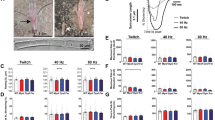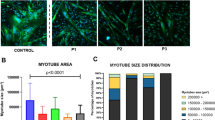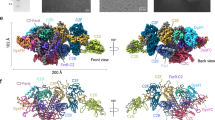Abstract
Mutations in dysferlin, a member of the fer1-like protein family that plays a role in membrane integrity and repair, can give rise to a spectrum of neuromuscular disorders with phenotypic variability including limb-girdle muscular dystrophy 2B, Myoshi myopathy and distal anterior compartment myopathy. To improve the tools available for understanding the pathogenesis of the dysferlinopathies, we have established a large source of highly specific antibody reagents against dysferlin by selection of heavy-chain antibody fragments originating from a nonimmune llama-derived phage-display library. By utilizing different truncated forms of recombinant dysferlin for selection and diverse selection methodologies, antibody fragments with specificity for two different dysferlin domains could be identified. The selected llama antibody fragments are functional in Western blotting, immunofluorescence microscopy and immunoprecipitation applications. Using these antibody fragments, we found that calpain 3, which shows a secondary reduction in the dysferlinopathies, interacts with dysferlin.
Similar content being viewed by others
Log in or create a free account to read this content
Gain free access to this article, as well as selected content from this journal and more on nature.com
or
References
Liu J, Aoki M, Illa I et al: Dysferlin, a novel skeletal muscle gene, is mutated in Miyoshi myopathy and limb girdle muscular dystrophy. Nat Genet 1998; 20: 31–36.
Bashir R, Britton S, Strachan T et al: A gene related to Caenorhabditis elegans spermatogenesis factor fer-1 is mutated in limb-girdle muscular dystrophy type 2B. Nat Genet 1998; 20: 37–42.
Illa I, Serrano-Munuera C, Gallardo E et al: Distal anterior compartment myopathy: a dysferlin mutation causing a new muscular dystrophy phenotype. Ann Neurol 2001; 49: 130–134.
Ueyama H, Kumamoto T, Horinouchi H, Fujimoto S, Aono H, Tsuda T : Clinical heterogeneity in dysferlinopathy. Intern Med 2002; 41: 532–536.
Davis DB, Delmonte AJ, Ly CT, McNally EM : Myoferlin, a candidate gene and potential modifier of muscular dystrophy. Hum Mol Genet 2000; 9: 217–226.
Yasunaga S, Grati M, Chardenoux S et al: OTOF encodes multiple long and short isoforms: genetic evidence that the long ones underlie recessive deafness DFNB9. Am J Hum Genet 2000; 67: 591–600.
Bansal D, Miyake K, Vogel SS et al: Defective membrane repair in dysferlin-deficient muscular dystrophy. Nature 2003; 423: 168–172.
Prelle A, Sciacco M, Tancredi L et al: Clinical, morphological and immunological evaluation of six patients with dysferlin deficiency. Acta Neuropathol (Berl) 2003; 105: 537–542.
Piccolo F, Moore SA, Ford GC, Campbell KP : Intracellular accumulation and reduced sarcolemmal expression of dysferlin in limb-girdle muscular dystrophies. Ann Neurol 2000; 48: 902–912.
Matsuda C, Hayashi YK, Ogawa M et al: The sarcolemmal proteins dysferlin and caveolin-3 interact in skeletal muscle. Hum Mol Genet 2001; 10: 1761–1766.
McNally EM, de Sa ME, Duggan DJ et al: Caveolin-3 in muscular dystrophy. Hum Mol Genet 1998; 7: 871–877.
Hoogenboom HR : Overview of antibody phage-display technology and its applications. Methods Mol Biol 2002; 178: 1–37.
Muyldermans S, Lauwereys M : Unique single-domain antigen binding fragments derived from naturally occurring camel heavy-chain antibodies. J Mol Recognit 1999; 12: 131–140.
Zhang J, Tanha J, Hirama T et al: Pentamerization of single-domain antibodies from phage libraries: a novel strategy for the rapid generation of high-avidity antibody reagents. J Mol Biol 2004; 335: 49–56.
Tanha J, Dubuc G, Hirama T, Narang SA, MacKenzie CR : Selection by phage display of llama conventional V(H) fragments with heavy chain antibody V(H)H properties. J Immunol Methods 2002; 263: 97–109.
Frenken LG, van der Linden RH, Hermans PW et al: Isolation of antigen specific llama VHH antibody fragments and their high level secretion by Saccharomyces cerevisiae. J Biotechnol 2000; 78: 11–21.
van Koningsbruggen S, de Haard H, de Kievit P et al: Llama-derived phage display antibodies in the dissection of the human disease oculopharyngeal muscular dystrophy. J Immunol Methods 2003; 279: 149–161.
Aoki M, Liu J, Richard I et al: Genomic organization of the dysferlin gene and novel mutations in Miyoshi myopathy. Neurology 2001; 57: 271–278.
Liu B, Huang L, Sihlbom C, Burlingame A, Marks JD : Towards proteome-wide production of monoclonal antibody by phage display. J Mol Biol 2002; 315: 1063–1073.
Kazemier B, de Haard H, Boender P, van Gemen B, Hoogenboom H : Determination of active single chain antibody concentrations in crude periplasmic fractions. J Immunol Methods 1996; 194: 201–209.
Cooper ST, Lo HP, North KN : Single section Western blot: improving the molecular diagnosis of the muscular dystrophies. Neurology 2003; 61: 93–97.
Vu KB, Ghahroudi MA, Wyns L, Muyldermans S : Comparison of llama VH sequences from conventional and heavy chain antibodies. Mol Immunol 1997; 34: 1121–1131.
Harmsen MM, Ruuls RC, Nijman IJ, Niewold TA, Frenken LG, de Geus B : Llama heavy-chain V regions consist of at least four distinct subfamilies revealing novel sequence features. Mol Immunol 2000; 37: 579–590.
Walter MC, Braun C, Vorgerd M et al: Variable reduction of caveolin-3 in patients with LGMD2B/MM. J Neurol 2003; 250: 1431–1438.
Fanin M, Pegoraro E, Matsuda-Asada C, Brown Jr RH, Angelini C : Calpain-3 and dysferlin protein screening in patients with limb-girdle dystrophy and myopathy. Neurology 2001; 56: 660–665.
Anderson LV, Harrison RM, Pogue R et al: Secondary reduction in calpain 3 expression in patients with limb girdle muscular dystrophy type 2B and Miyoshi myopathy (primary dysferlinopathies). Neuromuscul Disord 2000; 10: 553–559.
Lennon NJ, Kho A, Bacskai BJ, Perlmutter SL, Hyman BT, Brown Jr RH : Dysferlin interacts with annexins A1 and A2 and mediates sarcolemmal wound-healing. J Biol Chem 2003; 278: 50466–50473.
Lou J, Marzari R, Verzillo V et al: Antibodies in haystacks: how selection strategy influences the outcome of selection from molecular diversity libraries. J Immunol Methods 2001; 253: 233–242.
Nicholson LV : The ‘rescue’ of dystrophin synthesis in boys with Duchenne muscular dystrophy. Neuromuscular Disord 1993; 3: 525–531.
Taveau M, Bourg N, Sillon G, Roudaut C, Bartoli M, Richard I : Calpain 3 is activated through autolysis within the active site and lyses sarcomeric and sarcolemmal components. Mol Cell Biol 2003; 23: 9127–9135.
Acknowledgements
We thank Dr Ruth Harrison and Dr Zohar Argov for providing muscle biopsies of the two British patients. This study was made possible by grants from IOP Genomics Senter (IGE01019A) and the National Institutes of Health (NIH-NIAMS R21-AR48327-01). SL and FH are funded by the Muscular Dystrophy Campaign.
Author information
Authors and Affiliations
Corresponding author
Rights and permissions
About this article
Cite this article
Huang, Y., Verheesen, P., Roussis, A. et al. Protein studies in dysferlinopathy patients using llama-derived antibody fragments selected by phage display. Eur J Hum Genet 13, 721–730 (2005). https://doi.org/10.1038/sj.ejhg.5201414
Received:
Revised:
Accepted:
Published:
Issue date:
DOI: https://doi.org/10.1038/sj.ejhg.5201414
Keywords
This article is cited by
-
Faster regeneration associated to high expression of Fam65b and Hdac6 in dysferlin-deficient mouse
Journal of Molecular Histology (2019)
-
Novel Missense CAPN3 Mutation Responsible for Adult-Onset Limb Girdle Muscular Dystrophy with Calves Hypertrophy
Journal of Molecular Neuroscience (2019)
-
Statistical Test of Expression Pattern (STEPath): a new strategy to integrate gene expression data with genomic information in individual and meta-analysis studies
BMC Bioinformatics (2011)
-
Identification by phage display of single-domain antibody fragments specific for the ODD domain in hypoxia-inducible factor 1alpha
Laboratory Investigation (2006)



